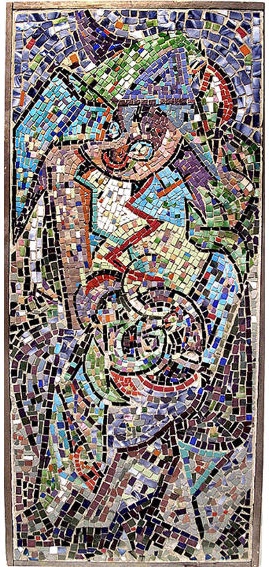
There is a delightful mosaic scene in the biopic “Pollock” (2000), starring Ed Harris as the painter, and Marcia Gay Harnden (who received an Oscar for this role) playing his wife Lee Krasner. At just over an hour and 4 minutes, Krasner is seen creating a mosaic table. Four minutes later it resurfaces – only just visible if you’re watching carefully – in a poker scene, holding beer bottles at Jackson and Lee’s house one evening. And again, at 1 hour and 21 minutes, with some coffee table books and coffee cups while Jackson’s family is visiting following his success being featured in Life Magazine…
It’s inconsequential to the movie and you’ll miss it if you’re not into mosaics, as I did the first time, watching it two years prior to starting out in mosaic art. I retraced and re-watched it only years later, when I became curious about the source of the mosaic in the photo by this article, which I had enlarged and printed on real photo paper and stuck on my computer screen, to inspire myself to “one day be a real mosaicist” (a goal I’m still working towards!). I had found it on the internet and did not know who it was from.
The reason I had picked this mosaic to be my inspiration was the deceptively randomness and simplicity of the design, the use of a wide variety of materials, the playful rhythm and vibrant colours. But most of all: how looking at it made me feel happy, carefree and alive. I knew one day I wanted to make mosaics like this.
I had no idea I was punching above my weight. Lee Krasner is the sole woman artist mentioned as part of the first generation of Abstract Expressionists, who exhibited alongside Picasso, Matisse, de Kooning and Pollock himself. But once I found out it was her who created my mosaic muse, it gave me a wonderful inner validation of the mosaic style I aspired to.

It turns out this table was one of two low, round mosaic tables Lee Krasner (who was predominantly a painter) made around 1947 or 1948, using pieces of her own jewellery, everyday objects such as keys and coins, as well as tiles and bottle glass. According to other sources, Jackson Pollock gave Lee all his leftover material and encouraged her to do her own mosaic after he created his only mosaic for the Work Progress Association (which was rejected).
The story goes that Jackson Pollock helped her pour the concrete and attach the wagon wheel rim to the legs. But she laid the mosaic pattern.
“It’s a landmark work in terms of decorative arts and has been reproduced in many contexts and published widely,” says Hallie Harrisburg of Michael Rosenfield Gallery, interviewed by “Mosaic of Art”.
According to Harrisburg, the mosaic table was a foreshadowing of Krasner using the abstract form as her own language in her paintings later on.
One of the tables was sold, but my favourite stayed in Lee Krasner’s possession her entire life.
© Sitara Morgenster
Become a supporter
This blog was also published as an article in the February 2018 issue of “Opus Oracle”, the members-only magazine of MAANZ (Mosaic Association of Australia and New Zealand) as well as on my mosaic website, www.mosaics.gallery




